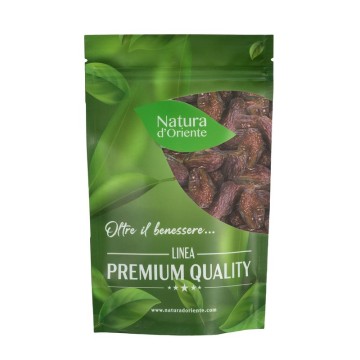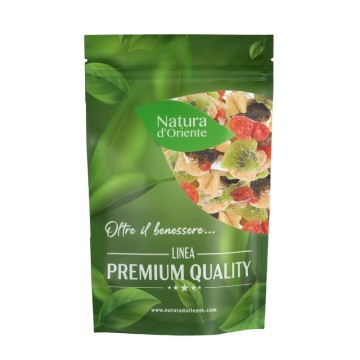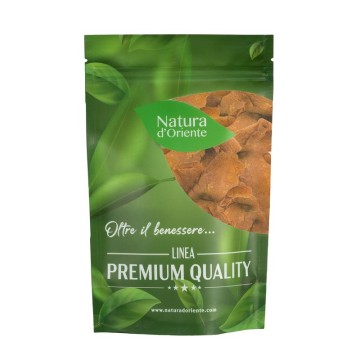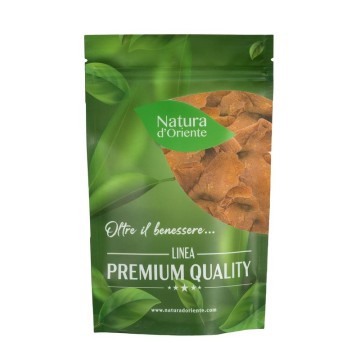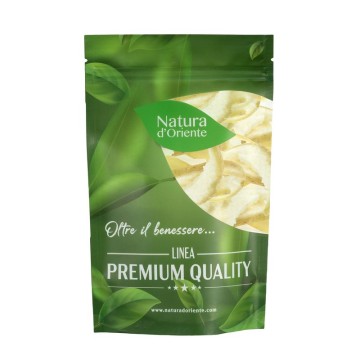Dehydrated oranges
This type of dehydrated fruit reveals important properties, both for the low content of saturated fats and for the richness of soluble fiber and natural antioxidants. Furthermore, thanks to the slicing, dried oranges are delicious and easy to use. They bring all the benefits of fresh oranges, as dehydration does not completely alter the nutrients.
Dehydrated oranges: properties and benefits
In addition to their amazing flavor, this dried fruit is an excellent source of valuable nutrients. Oranges are among the fruits that make vitamin C available to our body, so essential for the proper functioning of the immune and nervous systems; in addition to its action as an antioxidant substance. Vitamin C contributes greatly to the growth and repair of tissues, including those of blood vessels, cartilage, gums and teeth, bones - it helps to better absorb calcium (a mineral that is still present in orange in a good dose). Additionally, vitamin C can help the body absorb other nutrients, such as iron.
The antioxidants contained in oranges help with the beauty of the skin, and against the damage of free radicals on our cells - known to cause the signs of aging. This vitamin can have a beneficial invigorating effect, reducing psycho-physical fatigue. In fact, it contributes to the reintegration of energy after physical effort. In addition, the properties of the soluble fiber inside the oranges and the low sodium content help to maintain the well-being of the body at the level of regular blood pressure, and normal blood cholesterol levels.
Dried orange is also rich in vitamin A, another great essential element that you can find in dried oranges. This vitamin is also beneficial for skin health, and is good for the eyes - it can protect them from age-related problems.
Origins and History of cultivation
A fruit known since ancient times, among citrus fruits, the sweet orange is the most cultivated in the world, since it easily adapts to variable environmental conditions. It is not yet clear what its origin is, but however there is the presence of oranges in China, where it is thought that the sweet orange originated from the bitter one over 4000 years ago. In Asia Minor it came from Arab trade, then passed through Egypt, North Africa and finally Europe.
In ancient times, the orange appears in Greek mythology evoked by Juno, wife of Jupiter, who brought as a dowry saplings with golden fruits, oranges: a symbol of fertility and love. In fact, orange blossoms are always a good omen for a wedding!
In the Middle Ages in Sicily, under the Arab domination (IX-XI AD) bitter oranges were cultivated in the gardens as ornamental plants. Only in the Renaissance did the cultivation of sweet orange begin in Italy, in particular in Sicily and Calabria, after the introduction by the Portuguese. - in many dialects, in fact, the orange was called "Portugal". A plant that assumed importance in the eighteenth century, and which is still very much appreciated today for its beauty and its fruits.
Plant and Fruit
Orange (Citrus sinensis L.) is a tree belonging to the Rutaceae family, which gives the fruit of oranges, sometimes called sweet oranges to distinguish them from bitter oranges. It is probably a plant - hybrid, a cross between pomelo and mandarin. In height it can reach up to 12 meters, with elongated leaves and white flowers. The fruits we know well are round and orange, with a rough skin, and can be abundant in the harvest.
The tree blooms and bears fruit at the same time, as it only rests for 3 months, and the first oranges can be harvested in November, while the last ones in May and June. There are many varieties of orange, given that it is a citrus that grows all over the world, and among the most famous are those with red pulp, those with blond pulp, with thin or spent peel. There are varieties for table fruit, squeezed fruit, for the production of juices, candied fruit and dried oranges.
Nutritional values of dehydrated orange
Orange is an average calorie fruit with about 340 Kcal per 100 grams. It does not contain fat (0%), but fiber, protein (about 1.25 g / 100g), potassium (about 200 mg / 100g), calcium (about 40 mg / 100 g). This fruit is rich in vitamin C (about 200 mg / 100 g) and vitamin A.
How to consume dried oranges in the kitchen or as a snack
Oranges that have been dehydrated and transformed into a crunchy snack, using sweet slices, can also be used in the kitchen for the preparation of other dishes, as well as as a snack. It can be added
grease dried orange with tea, yogurt, as a top decoration for ice cream and cupcakes, for cakes or muffins. In addition, you can also prepare a salad with dried oranges, or add them to a mix of cereals and dried fruit. Dried orange can also be used as a delicious side dish in some recipes to contrast with the salty.
You can also add dried oranges to your cold drinks like smoothies or cocktails, to make them different and enjoyable. Like many dried fruits, dehydrated orange can also be used in energy bar preparations.
Dehydrated orange: side effects and contraindications
There are no particular contraindications to taking this dried fruit, but we know that dried fruit normally contains more sugar than fresh fruit. So it is best not to abuse this food for diabetes sufferers. In large doses the dried orange could cause a laxative action or acidity in the stomach. It is always important to know the recommended dose of dried oranges in a day, which represents around 20 grams.
![]()






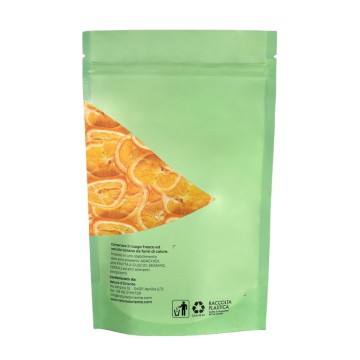


 No reward points for this product.
No reward points for this product.

